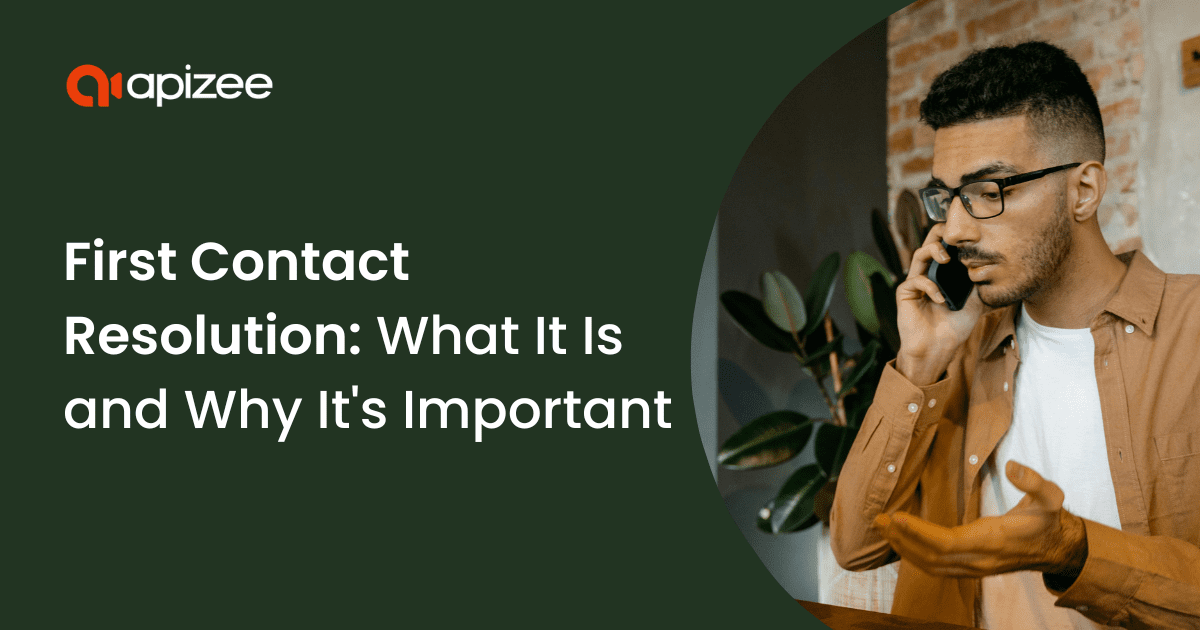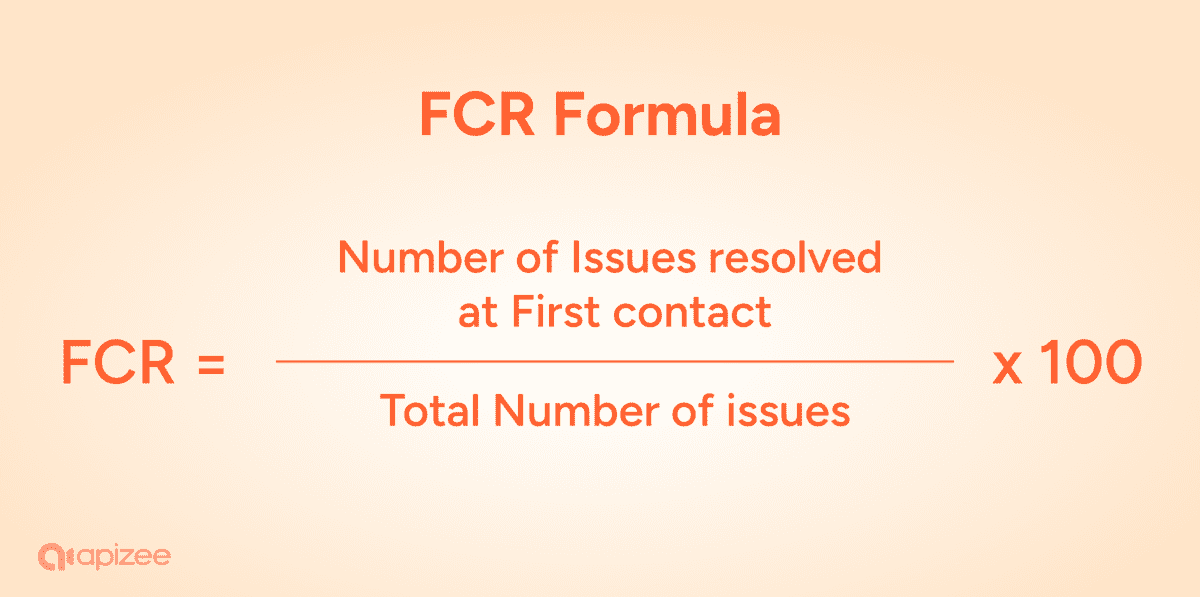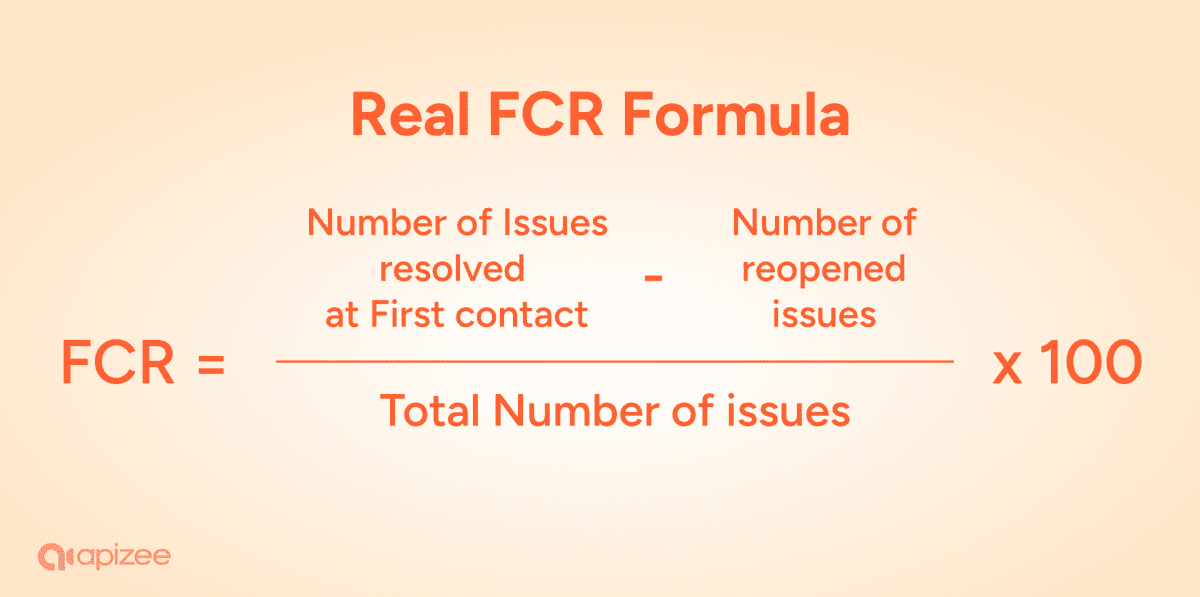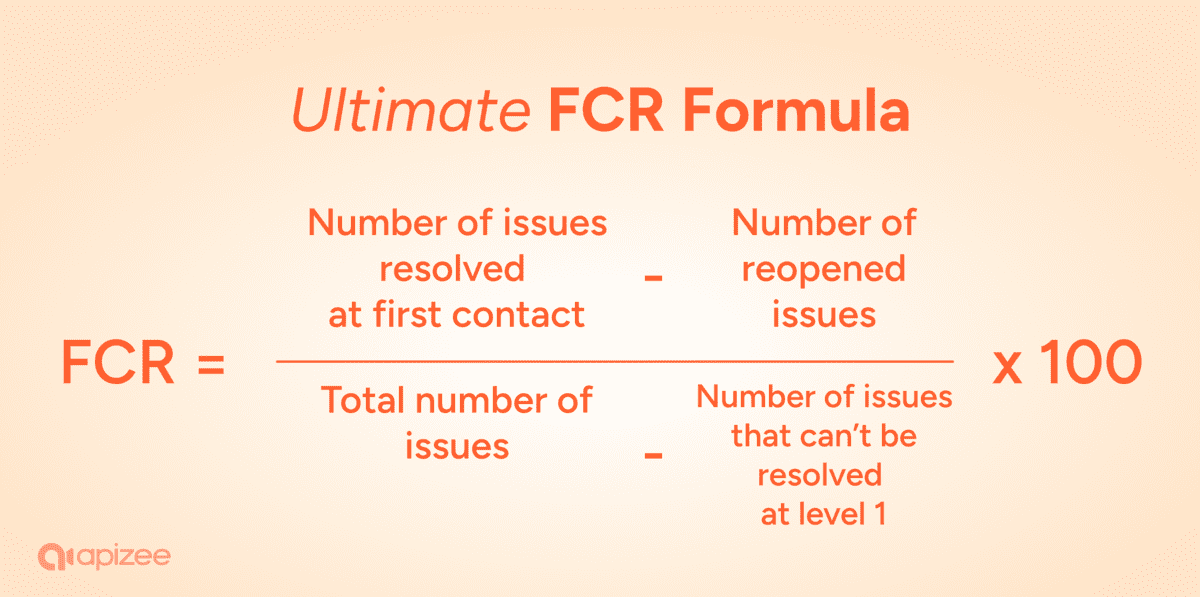Maximizing First Contact Resolution to enhance Customer Experience



The concept of First Contact Resolution (FCR) has emerged as a pivotal performance indicator in the realm of call centers and customer service.
Recent studies have highlighted significant variability in FCR across various industries. Research indicates that FCR rates vary drastically between sectors, ranging from 44% to 92%, with an industry average of 71% for call centers. This variability underscores the inherent challenges in achieving a high level of FCR, as well as the opportunities for improvement in many areas.
The First Contact Resolution Rate, a critical Key Performance Indicator (KPI) in call centers and customer service departments, measures an organization's ability to address customer requests or issues on the first call or contact, without needing follow-ups or additional interactions. This rate directly reflects the efficiency and quality of customer service provided.
The First Contact Resolution rate is calculated by dividing the number of requests resolved on the first contact by the total number of issues received by customer service. It serves as a direct indicator of customer service agents' performance and the efficiency of internal processes.
A high FCR rate means quick problem resolution, reducing call volume and agents' workload. This leads to lower operational costs, as fewer time and resources are needed to handle repeated queries.
FCR is closely related to customer satisfaction. Quick and effective problem resolution increases customer trust and loyalty.
FCR is a crucial barometer for assessing customer service quality. A high FCR rate equates to efficiency, cost savings, and consequently, satisfied and loyal customers.
The First Contact Resolution rate (FCR) is a crucial indicator for customer services for several key reasons.
In summary, the First Contact Resolution rate is a barometer of customer service effectiveness and quality.
Here’s an explanation of FCR calculation methods and the importance of choosing a method suited to each organization.
The basic formula for calculating the First Contact Resolution rate is straightforward. It is as follows:

The result is expressed as a percentage, offering a clear measure of how effectively a customer service manages to resolve issues on the first contact. For example, an FCR of 80% means that 80% of customer issues were resolved on their first call with customer service.
It is important to note that this formula can vary slightly depending on an organization's specifics and how it defines a "resolved issue" and a "first contact." Some companies may choose to include or exclude specific types of contacts or adjust the follow-up period for repeated calls. These nuances must be considered to ensure that the FCR calculation accurately reflects the organization's customer service performance.
Find out how efficient your customer service is by calculating your first contact resolution rate with our FCR calculator.
Calculate my FCR rateWhen a ticket is reopened, it often indicates that the issue was not fully resolved on the first contact. These cases should be subtracted from the total number of problems resolved on the first contact, as they represent situations where additional contact was necessary.
As a result, the formula becomes:

Some types of contacts, such as hardware repairs or physical requests for move/add/change, cannot be resolved remotely by the help desk. The question is whether these contacts affect the calculation of FCR for a help desk. The answer is both yes and no. Gross FCR considers all incoming contacts without adjustment for those that cannot be resolved by first-level support.
On the other hand, Net FCR adjusts the measure to exclude contacts that cannot be resolved remotely by the help desk. Specifically, the calculation of Net FCR discards contacts that cannot be resolved at the first level.
The Net FCR formula is:

In other words, contacts for which level-1 support practically cannot handle the issue are excluded from the total number of issues. These adjustments are sometimes called "carve-outs."
In any case, whether you track Gross or Net FCR, your customer will not notice the difference. Customer experience is linked to your Gross FCR, and it is essential that your customer service can resolve the maximum number of issues directly, without having to pass the case to another service.
The First Contact Resolution (FCR) rate varies across sectors. It's crucial to benchmark within the correct category, while remembering that FCR is a highly contextual indicator based on how you define key moments in your customer service process.
In retail, the average FCR stands at 77%, peaking at 88%. This highlights the sector's efficiency in responding to customers in this dynamic area where customer experience is a priority.
Non-profit organizations show an average FCR of 75%, with a high of 88%. This reflects the emphasis on efficiency and quick resolution of issues to maintain trust among donors and beneficiaries.
The insurance sector displays an average FCR of 73% and a best-case scenario of 84%. Insurance companies strive to offer quick and accurate solutions, given the complexity of the cases handled.
Health insurance demonstrates an average FCR of 68% and a maximum of 84%, indicating a notable ability to effectively manage complex customer queries.
For governmental services, the average FCR is 72%, with the highest rate at 82%. This highlights ongoing efforts to improve the efficiency of public services despite the diversity and complexity of requests.
The energy sector shows an average FCR of 68% and reaches 82% in the best cases, indicating improvements in managing customer interactions despite the technical nature of inquiries.
In finance, the average FCR is 65%, rising to 79%. This reflects the challenges associated with the diversity of financial products and services.
Technical support stands out with an average FCR of 61% and a high of 73%, understandable given the technical complexity of the issues encountered.
For telecommunications, the average FCR is 52% with a maximum performance of 68%, suggesting opportunities for improvement in resolving customers' technical problems.
Finally, the general average for call centers is 68% with a high of 91%, illustrating the critical importance of first-contact resolution in the customer service industry.
This study reveals that the FCR rate varies significantly across sectors. However, we primarily suggest focusing on the progression of your FCR over time.
Several factors contribute to a low FCR rate:
A significant portion of FCR challenges stems from human errors and organizational issues. Notably, 38% of FCR problems are due to mistakes made by agents, while 49% result from inadequate organizational policies and procedures. These figures underscore the importance of adequate agent training and the revision of internal processes to optimize FCR.
Communication also plays a crucial role. It's noted that 13% of FCR issues are related to misunderstandings by clients. Common reasons for callbacks include the need for the client to check the status of their unresolved issue, disconnections during waiting, or agents' lack of knowledge to solve the problem. These factors point to the need to enhance communication skills and call management.
In 2023, the high agent turnover rate, estimated at 38%, and burnout are considered the primary obstacles to a good FCR rate. The increase in remote work, labor shortages, and challenges related to motivation and agent training are factors affecting FCR. These trends highlight the necessity to adapt human resource management and training strategies to the new realities of work.
In conclusion, achieving a high FCR rate requires a holistic approach that considers agent skills, organizational processes, and external challenges. Special attention to these aspects can significantly transform the support experience for agents, customers, and the organization as a whole.
Improving the First Contact Resolution (FCR) rate is crucial for optimizing call center efficiency and customer satisfaction.
Here are 4 key strategies to achieve this:
Agent training is key to exceptional customer service. Investing in ongoing training ensures each agent is equipped with the skills needed to excel. This goes beyond product or service knowledge; it's about mastering communication, agile problem-solving, and empathetic emotion management. Well-trained agents drive high First Contact Resolution rates.
According to SQM Group, a 1% improvement in FCR can lead to a 1% increase in customer satisfaction, highlighting the direct impact of skilled agents on customer experience.
Well-trained agents don't just answer questions; they create memorable experiences, build client trust, and establish lasting relationships. It’s an investment that translates to satisfied, loyal customers and more efficient customer service operations.
To boost FCR, a thorough analysis of previous calls is essential. Reviewing interactions where FCR wasn't achieved uncovers weaknesses. Each unresolved call is a goldmine of information. SQM Group's 2021 study found that understanding why some calls don't achieve FCR can reduce operational costs by 1% for every percentage improvement in FCR.
La simplification des procédures internes est tout aussi cruciale. Un processus compliqué est comme un labyrinthe pour les agents et les clients. En le rendant plus fluide, on accélère la résolution des problèmes. Une étude de Harvard Business Review montre que la facilité de résolution est un facteur clé de la satisfaction client. En simplifiant les processus, les agents peuvent se concentrer sur l'essentiel : répondre efficacement aux besoins des clients.
Simplifying internal procedures is equally crucial. A complicated process is a maze for agents and customers alike. By streamlining it, problem resolution speeds up. Harvard Business Review study shows that ease of resolution is a key customer satisfaction factor. Simplifying processes allows agents to focus on what's essential: effectively meeting customer needs.
Equipping agents with decision support tools and insights is a giant step toward improving FCR. Imagine an agent who, with an efficient CRM and documentation at hand, instantly finds answers relevant to their ongoing conversation with a customer. Visual engagement, like live video chat, also transforms client interactions.
It's like seeing the missing piece of a complex puzzle in real-time. The agent sees and understands the client's problem better, finding solutions faster. Not only is this effective, but it also creates a more human, reassuring connection for the client.
Automation and artificial intelligence (AI) are the superheroes of modern customer service. They handle repetitive tasks, giving agents more time for complex issues. According to Salesforce, 51% of customer service teams already use AI, with 46% planning to increase their AI usage within two years. This highlights that the future of customer service lies in a smart combination of human and technological resources.
Acknowledging FCR as a key performance indicator creates positive dynamics within the team. Imagine an environment where each call resolution is celebrated, successes are shared, and effort is recognized. In such a world, agents feel valued and motivated.
But how to maintain this momentum? The key is in feedback and continuous improvement. Implementing regular feedback mechanisms, like customer satisfaction surveys or team debriefing sessions, keeps a pulse on performance. These sharing moments are crucial to understand what works and what can be improved. Active listening and adaptation are powerful drivers to boost FCR and, by extension, customer satisfaction.
First Contact Resolution (FCR) and First Call Resolution may seem interchangeable, but they have distinct nuances. FCR is the overarching term that measures the resolution of a customer's query at the first point of contact, regardless of the communication channel used. This includes phone, email, chat, or even face-to-face support.
First Call Resolution, as the name suggests, is specific to telephone calls. It assesses how effectively customer issues are resolved on the first call, without considering other communication channels the customer might use.
While similar, these terms highlight the importance of understanding the customer experience across different channels. An effective resolution strategy across all fronts can lead to better overall customer satisfaction and loyalty.
First Contact Resolution (FCR) and First Response Time (FRT) are two crucial metrics in customer service, each offering unique insights into service quality. FCR measures the effectiveness of resolving customer issues during the initial interaction, highlighting the efficiency of problem-solving processes.
A higher FCR rate often correlates with increased customer satisfaction and loyalty, as it demonstrates a company's ability to address concerns swiftly and effectively. On the other hand, FRT focuses on the speed of the initial response to a customer inquiry.
While not necessarily resolving the issue, a quick FRT can significantly enhance customer experience by showing attentiveness and a commitment to prompt service. Both metrics, when optimized, contribute to a superior overall customer service experience.
In summary, First Contact Resolution (FCR) is a crucial indicator of call center performance, directly influencing customer satisfaction and loyalty. Its continuous improvement is vital for enhancing customer service quality and the company's perception.
Besides FCR, other metrics like average response time, customer satisfaction rate (CSAT), Net Promoter Score (NPS), and customer retention rate are also essential for assessing and enhancing the overall effectiveness of customer service. These indicators, when combined, provide a comprehensive view of performance and opportunities for improvement in customer relationship management.
"FCR" stands for "First Contact Resolution" or "First-Call Resolution," depending on the channels used to receive and process customer issues.
Live video chat can enhance FCR by allowing agents to better understand customer issues through visual interaction. This can be especially useful for technical or complex problems where verbal or written explanations are insufficient. The ability to see the problem in real-time can speed up resolution and improve the customer experience.
FCR can vary significantly across channels. For instance, phone calls allow real-time interaction, which can facilitate quick resolution, while emails may lead to delays. Online chats offer responsiveness similar to calls but can be limited by the clarity of explanations provided by customers.
A high FCR can significantly reduce operational costs. Fewer callbacks mean less time spent by agents on the same issue, thus reducing work time and associated costs. Moreover, good FCR improves overall efficiency, which can lessen the need for hiring more staff.
Customer feedback can be integrated by conducting post-interaction satisfaction surveys, analyzing reasons for callbacks, and collecting direct comments on service channels. This information can then be used to identify areas needing improvement and to train agents.
FCR can be a useful indicator of agent performance, but it should be used cautiously. It's important to consider the context of interactions and not penalize agents for issues that are not solely dependent on them.
FCR often correlates with other metrics such as average wait time and customer satisfaction rate. A reduced waiting time enhances the customer experience and increases the likelihood of resolving issues on the first contact. An improved FCR directly translates into higher customer satisfaction (CSAT). Similarly, a high first attempt resolution rate directly contributes to better FCR.
Explore key findings from the Genesys State of Customer Experience report. Learn how AI, omnichannel strategies, and video chat are transforming CX and enhancing customer satisf...
The State of Customer Experience report by Genesys : Key Insights and Trends
27 Mar 2025
Despite AI and automation, customers still prefer to speak to a human for support. Discover why human interaction remains essential for great customer service.
Why Customers Still Want to Speak to a Human in Customer Service
17 Mar 2025
Discover the top customer experience influencers in Europe, shaping the future of CX and customer service.
Top 100 Customer Experience Influencers to follow
10 Mar 2025
Interested in our solutions?